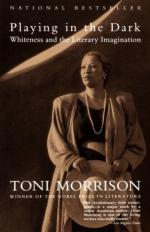
|
| Name: _________________________ | Period: ___________________ |
This test consists of 15 multiple choice questions and 5 short answer questions.
Multiple Choice Questions
1. Who was criticized by a scholar who deemed the term "darky" acceptable?
(a) Toni Morrison.
(b) John Steinbeck.
(c) Edgar Allen Poe.
(d) Sylvia Plath.
2. What did Cardinal tell her doctor not to keep in his office?
(a) A gargoyle.
(b) A framed photo of Louis Armstrong.
(c) A water dish for his cat.
(d) A clock.
3. Who is Sapphira jealous of?
(a) Her slave.
(b) Her mother.
(c) Her daughter.
(d) Her sister.
4. What does Morrison describe Sapphira and the Slave Girl as being an example of?
(a) Willful critical blindness.
(b) Urgency in American literature.
(c) Fulfilling language and lackluster art.
(d) Immediate Africanist presence.
5. Who does Sapphira plot to rape her slave?
(a) Her brother.
(b) Her son.
(c) Her nephew.
(d) Her husband.
6. According to Morrison, what do reading and writing require?
(a) Alertness.
(b) Fear.
(c) Perseverance.
(d) Anger.
7. Where does Morrison claim to apply the knowledge in Playing in the Dark?
(a) The way she communicates.
(b) The way she reads.
(c) The way she argues.
(d) The class she teaches.
8. What does Morrison wonder most about Cardinal?
(a) Why she went to a Louis Armstrong concert.
(b) Why she wrote a book.
(c) When she knew she was in trouble.
(d) When she felt she had to panic.
9. Which of the following does Morrison acknowledge?
(a) That each reader reads differently.
(b) That each author is biased.
(c) That each reader is looking for something different.
(d) That each writer tries to avoid writing about race.
10. In the attack on Algeria, what does Cardinal see?
(a) Vengeful slaughter of an innocent.
(b) White slaughter of an Indian mother.
(c) White slaughter of a black mother.
(d) White slaughter of a white mother.
11. Who is the author of What Maisie Knew?
(a) Gertrude Stein.
(b) Toni Morrison.
(c) Willa Cather.
(d) Henry James.
12. Who is the author of Three Lives?
(a) Willa Cather.
(b) Marie Cardinal.
(c) Gertrude Stein.
(d) Henry James.
13. Which group, according to Morrison, is more likely to claim that racism is neutral?
(a) Asians.
(b) Africans.
(c) Europeans.
(d) Americans.
14. What is Morrison interested in determining about domination?
(a) How domination becomes possible.
(b) Where domination comes from.
(c) How domination spreads.
(d) Who encourages domination.
15. In what role does Morrison describe herself as assuming nothing happens?
(a) Writer.
(b) Black woman.
(c) European.
(d) Reader.
Short Answer Questions
1. How many years back did the presence of African-Americans in the US begin?
2. Who wrote The Words to Say It?
3. What does Morrison argue for extending?
4. According to Morrison, what do readers and writers fight for?
5. Who did Morrison thank for helping her with the book?
|
This section contains 429 words (approx. 2 pages at 300 words per page) |

|




